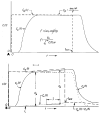Estimation of blood flow with radioactive tracers
- PMID: 775641
- PMCID: PMC3629953
- DOI: 10.1016/s0001-2998(76)80002-5
Estimation of blood flow with radioactive tracers
Abstract
The techniques of tracer dilution in the circulation, and of tracer uptake by and washout from an orgen, may be described using expressions that are general and are not dependent on specific models such as exponentials. The expressions have been applied to the measurement of cardiac output using impulse and constant rate injection techniques. Further expressions have been given for estimating organ blood flow from inflow/outflow concentration-time curves, and from the distribution of deposited tracer. Some problems with respect to the use of deposition techniques as they are ordinarily applied to the estimation of regional blood flow must be considered, particularly when there are capillary beds in series or where there is countercurrent diffusional shunting of diffusible tracers between inflow and outflow. This review deals with these various aspects of tracer theory as they relate to the measurement of blood flow.
Figures











References
-
- Zierler KL. Circulation times and the theory of indicator-dilution methods for determining blood flow and volume. In: Hamilton WF, Dow P, editors. Handbook of Physiology, vol 1, Section 2, Circulation. Washington, DC: American Physiological Society; 1962. p. 585.
-
- Zierler KL. Equations for measuring blood flow by external monitoring of radioisotopes. Circ Res. 1965;16:309. - PubMed
-
- González-Fernández JM. Theory of the measurement of the dispersion of an indicator in indicator-dilution studies. Circ Res. 1962;10:409. - PubMed
-
- Wood EH. Definitions and symbols for terms commonly used in relation to indicator-dilution curves. Circ Res. 1962;10:379.
-
- Bassingthwaighte JB, Chinard FP, Crone C, et al. Definitions and terminology for indicator dilution methods. In: Crone C, Lassen NA, editors. Capillary Permeability (Alfred Benzon Symposium II) Copenhagen: Ejnar Munksgaard; 1970. p. 665.
Publication types
MeSH terms
Substances
Grants and funding
LinkOut - more resources
Full Text Sources
Other Literature Sources

